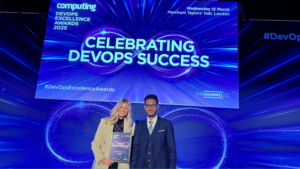
How product management improves public sector digital services
Product management plays a growing part in how the public sector delivers services to users. At Zaizi, we see the value the discipline brings in delivering great services for our clients in border and national security.
Product management’s big advantage is its evidence-based approach, which helps maximise the benefits for both users and the organisation. But despite its growing adoption in government, some still struggle to understand the role and its full potential.
Recently, I came across a great blog post by Megha Jain, Head of Product at the Home Office, covering five common myths about product management.
Megha and I had the opportunity to collaborate briefly a few years ago, whilst I was working on the development of a Product Management Playbook for the Home Office, as part of their programme to become product-centric. We interviewed a range of product managers (of which Megha was one at the time) to gather insight into how product management was working within the Home Office and collate templates that could be shared.
In this blog, I’ll expand on Megha’s insightful perspective and share a bit about how we do it at Zaizi.
The role of the product manager
The first myth Megha busted was that product management is tied to sprint ceremonies and scrum events. Sprint ceremonies are aspects of Scrum methodology, part of a framework that helps teams to structure and manage their work and deliver in an agile and iterative way.
Product management focuses on the strategic development, maintenance and optimisation of products that solve user needs.
Scrum roles include a ‘Product Owner,’ which is sometimes confused with the role of a ‘Product Manager’. The terms are often used interchangeably but there is a difference. Whilst there is overlap, a product manager is focused beyond just development and has a much more holistic focus, leading on the vision of the product and building out the strategy to achieve this.
As a product manager, I attend Scrum ceremonies. Whilst I can lead them, I tend to leave that role to a delivery manager or a scrum master. This enables me to be a present participant rather than the facilitator and play the PM role of questioning and probing. Those meetings are pivotal to my role as they provide me with information and an opportunity to communicate with team members.
It’s worth noting that not all products are developed using Scrum. At Zaizi we tend to favour Scrum, however this isn’t a necessity. We use the methodology that suits the project and its needs.
As I have clocked up the years working in product management, I have gradually accepted that my job is about having conversations; with the user, the business stakeholders, techies, researchers, designers, delivery managers, data crunchers, purse-holders etc. I used to wonder when I would ever do any work but it turns out, that is work. And as long as you ensure it all turns into actions and delivers value to users, it’s all good.
Pinpoint your purpose and goal
Product managers always face pressure to add more features.
This can be difficult to counter because it can be hard to pinpoint your purpose and goal. You need to be very clear on who your target audience is and the biggest problem they need you to solve. The idea of being everything to everyone is attractive. People think ‘the more we do, the more people we reach, the more they use our product, and therefore the more impact (or money) we make’.
In marketing, the message loses its punch if it doesn’t speak to a specific audience and address a particular need. Likewise, products that try to be everything for everyone, often fall short.
Customers use a product with a purpose in mind. If we cloud the product with too many options, the user becomes overwhelmed and their experience is negatively affected. Ultimately, they will struggle to achieve their goal.
Here at Zaizi we run Transformation Days to help clients explore their most pressing digital challenges. It aligns stakeholders around the problem they are trying to solve, identifies the root cause and builds consensus on the desired outcome. By bringing people together and focusing the conversations, we can pinpoint their purpose and goals.
Transformation Day: solve your most pressing digital challenges
Be collaborative
At times, it’s hard to describe the role. It’s easy to quickly bumble an answer like: ‘I understand what users need and tell the techies what to build’. I have been guilty of this in the past but I know this is really not a helpful description and it paints the picture of an autocratic role.
I often describe my role as a translator or an interpreter who collects and communicates information in an altered state. But our roles are more than that. We are also facilitators, bringing together the different expertise and knowledge around us, users and business, and strategically aligning their goals. This requires us to work with others.
One key skill of the role is knowing when to listen to experts. A mistake I have seen in many aspiring product managers is the self-inflicted pressure of upskilling in tech and/or design areas. I agree with Megha that understanding the tech side is good for a product manager but you don’t need to write code, master AI algorithms, or be proficient in design software and user research techniques. A good product manager works collaboratively with others who have these skills.
Here at Zaizi we work within multi-disciplinary teams. It’s important to understand the skills of the team around you, know when to bring different people in and let everyone do what they do best.
You can’t be a good product manager and work alone. We depend on collaboration.
Find what customers need, not want
Initially I was going to say that customers always want things. But there are also times when customers don’t actually know what they want and asking them leads to confusion and mixed messages. It’s important that product managers challenge wants and make sense of uncertainty.
Our role is to understand what customers need, regardless of their wants. Along with our user-centred design colleagues, we cut through the wish list and get to the nitty gritty. We need to ask deep questions that get below the surface and uncover motivations and the problems that need solving. This is where I find the technique of asking why 5 times really helps (although I can’t confirm I always ask why exactly 5 times but it is the premise that you keep asking and digging that matters here).
During one digital transformation project, I realised the agreed priorities that informed the MVP roadmap were based on the original non-digital processes.
I deprioritised a key use case by asking questions and focusing on needs rather than wants. It was a challenging sell but proved correct when the MVP was released. They saw the digitalisation of the service meant the use case was no longer required. It has never been added in and this saved money and time.
Keep iterating and improving your products
Think about your house. It didn’t stop changing and being refined when they stopped building it. Three years ago I bought a neglected 230 year old house with holes in the roof. We soon found out it rained indoors! It took a lot of work and money to get it back into a damp-free, liveable state. In the same way, products need maintenance to remain usable.
We knocked down the wall between the pantry and small kitchen to make a larger, more sociable space to suit our family. The needs of a family of five in 2024 are very different to the needs when the house was originally built (and the owners had a maid!). The core needs haven’t changed, but they have evolved over time, and the kitchen needed updating accordingly.
Similarly, a product needs updating when circumstances and needs change. Especially in the digital world, where there is a constant escalator of new tech developments, new competitor offerings and new threats. The world in which the user lives evolves, so do the ways in which they interact with the product.
Getting a product live is not the end. It needs a plan for ongoing investment and attention to maintain, refine and evolve. At Zaizi, we don’t just focus on the exciting bits of the product lifecycle — discovery, alpha, and beta. We understand how important it is to look after products once they are live, provide continuous development, support, and maintenance, and be the eyes on the ground to ensure the product remains current.
Product management is important if you want to deliver user-centric services in the public sector. It means understanding the user’s pain points, collaborating with others to find solutions, and, as Megha aptly puts it, keeping the product ‘pulsing with life.’
If you want to know more about product management or how we use it at Zaizi to maximise value for users and our public sector clients in border and national security, get in touch.
-

The great legacy escape: Ditch the spreadsheets, drop the paper
-

The great legacy escape: How outdated systems and processes still hold government back
-

GDS’s research into AI in government – and how to deliver real value
-

From ScanApp to Lego demos — What you need to know about Security & Policing 2025
-

Truth, trust and transformation — 4 key takeaways from Zaizi’s AI in government event
-

Zaizi talent shines at Computing DevOps Excellence Awards 2025
